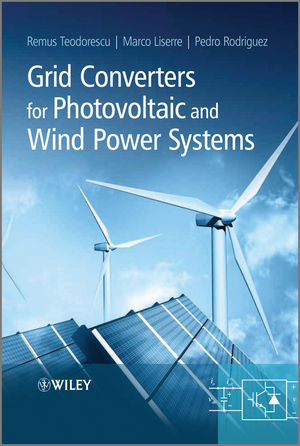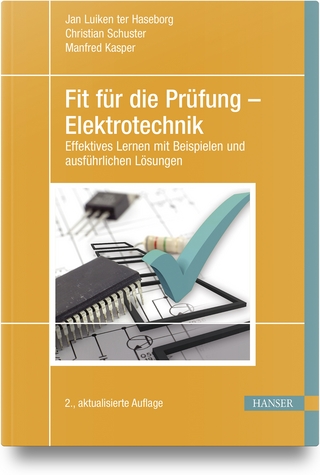
Grid Converters for Photovoltaic and Wind Power Systems
Wiley-IEEE Press (Verlag)
978-0-470-05751-3 (ISBN)
Grid converters are the key player in renewable energy integration. The high penetration of renewable energy systems is calling for new more stringent grid requirements. As a consequence, the grid converters should be able to exhibit advanced functions like: dynamic control of active and reactive power, operation within a wide range of voltage and frequency, voltage ride-through capability, reactive current injection during faults, grid services support. This book explains the topologies, modulation and control of grid converters for both photovoltaic and wind power applications. In addition to power electronics, this book focuses on the specific applications in photovoltaic wind power systems where grid condition is an essential factor.
With a review of the most recent grid requirements for photovoltaic and wind power systems, the book discusses these other relevant issues:
modern grid inverter topologies for photovoltaic and wind turbines
islanding detection methods for photovoltaic systems
synchronization techniques based on second order generalized integrators (SOGI)
advanced synchronization techniques with robust operation under grid unbalance condition grid filter design and active damping techniques
power control under grid fault conditions, considering both positive and negative sequences
Grid Converters for Photovoltaic and Wind Power Systems is intended as a coursebook for graduated students with a background in electrical engineering and also for professionals in the evolving renewable energy industry. For people from academia interested in adopting the course, a set of slides is available for download from the website. www.wiley.com/go/grid_converters
Remus Teodorecsu is currently an Associate Professor at the Institute of Technology, Aalborg University, teaching courses in power electronics and electrical energy system control for masters and PhD students. He has authored over 80 journal and conference papers, and one book Power Electronics: Computer Simulations (Technical Press Budapest, 1997), and also holds 3 patents. He is the founder and coordinator of the Green Power Laboratory at Aalborg University, focusing on the development and testing of grid converters for renewable energy systems, and is also co-recipient of the Technical Committee Prize Paper Awards at IEEE IAS Annual Meeting 1998, and IEEE Optim 2002. His research interests are in the design and control of power converters used in renewable energy systems, distributed generation, computer simulations and digital control implementation. Marco Liserre is currently Assistant Professor at the Bari Polytechnic, Italy, teaching courses in basic and advanced power electronics, and industrial electronics. His research interests are in the control of power converters and drives, power quality, and distributed generation, and he has authored 70 papers on these subjects, 13 of them having been published in international journals. He has worked towards several projects funded by the Italian government and has also lectured at Aalborg University, Delft University, and at the Warsaw University of Technology. He is Editor of the Newsletter of the Industrial Electronic Society, and Associate Editor of the IEEE Transactions on Industrial Electronics. Pedro Rodriguez received his M.S. and Ph.D. degrees in electrical engineering from the Technical University of Catalonia (UPC), Spain. He is currently an Associate Professor in the Electrical Engineering Department at the UPC, where he is the head of the Renewable Electrical Energy Systems (REES) center. He stayed as a researcher in the Department of Energy Technology (DET), at Aalborg University (Denmark), what resulted in close research collaboration. Currently, he is a regular Visiting Professor at the DET, where he participates as a co-supervisor in the Vestas Power Programme. His research activity lies on the field of electronic power processors applied to electrical distributed generation systems, being mainly focused on designing of controllers for the grid interactive power processors, designing power electronics based power processors for green energy sources, and proposing new technical solutions to improve stability and power quality in electrical networks.
About the Authors. Preface.
Acknowledgements.
1 Introduction.
1.1 Wind Power Development.
1.2 Photovoltaic Power Development.
1.3 The Grid Converter – The Key Element in Grid Integration of WT and PV Systems.
2 Photovoltaic Inverter Structures.
2.1 Introduction.
2.2 Inverter Structures Derived from H-Bridge Topology.
2.3 Inverter Structures Derived from NPC Topology.
2.4 Typical PV Inverter Structures.
2.5 Three-Phase PV Inverters.
2.6 Control Structures.
2.7 Conclusions and Future Trends.
3 Grid Requirements for PV.
3.1 Introduction.
3.2 International Regulations.
3.3 Response to Abnormal Grid Conditions.
3.4 Power Quality.
3.5 Anti-islanding Requirements.
3.6 Summary.
4 Grid Synchronization in Single-Phase Power Converters.
4.1 Introduction.
4.2 Grid Synchronization Techniques for Single-Phase Systems.
4.3 Phase Detection Based on In-Quadrature Signals.
4.4 Some PLLs Based on In-Quadrature Signal Generation.
4.5 Some PLLs Based on Adaptive Filtering.
4.6 The SOGI Frequency-Locked Loop.
4.7 Summary.
5 Islanding Detection.
5.1 Introduction.
5.2 Nondetection Zone.
5.3 Overview of Islanding Detection Methods.
5.4 Passive Islanding Detection Methods.
5.5 Active Islanding Detection Methods.
5.6 Summary.
6 Grid Converter Structures forWind Turbine Systems.
6.1 Introduction.
6.2 WTS Power Configurations.
6.3 Grid Power Converter Topologies.
6.4 WTS Control.
6.5 Summary.
7 Grid Requirements for WT Systems.
7.1 Introduction.
7.2 Grid Code Evolution.
7.3 Frequency and Voltage Deviation under Normal Operation.
7.4 Active Power Control in Normal Operation.
7.5 Reactive Power Control in Normal Operation.
7.6 Behaviour under Grid Disturbances.
7.7 Discussion of Harmonization of Grid Codes.
7.8 Future Trends.
7.9 Summary.
8 Grid Synchronization in Three-Phase Power Converters.
8.1 Introduction.
8.2 The Three-Phase Voltage Vector under Grid Faults.
8.3 The Synchronous Reference Frame PLL under Unbalanced and Distorted Grid Conditions.
8.4 The Decoupled Double Synchronous Reference Frame PLL (DDSRF-PLL).
8.5 The Double Second-Order Generalized Integrator FLL (DSOGI-FLL).
8.6 Summary.
9 Grid Converter Control for WTS.
9.1 Introduction.
9.2 Model of the Converter.
9.3 AC Voltage and DC Voltage Control.
9.4 Voltage Oriented Control and Direct Power Control.
9.5 Stand-alone, Micro-grid, Droop Control and Grid Supporting.
9.6 Summary.
10 Control of Grid Converters under Grid Faults.
10.1 Introduction.
10.2 Overview of Control Techniques for Grid-Connected Converters under Unbalanced Grid Voltage Conditions.
10.3 Control Structures for Unbalanced Current Injection.
10.4 Power Control under Unbalanced Grid Conditions.
10.5 Flexible Power Control with Current Limitation.
10.6 Summary.
11 Grid Filter Design.
11.1 Introduction.
11.2 Filter Topologies.
11.3 Design Considerations.
11.4 Practical Examples of LCL Filters and Grid Interactions.
11.5 Resonance Problem and Damping Solutions.
11.6 Nonlinear Behaviour of the Filter.
11.7 Summary.
12 Grid Current Control.
12.1 Introduction.
12.2 Current Harmonic Requirements.
12.3 Linear Current Control with Separated Modulation.
12.4 Modulation Techniques.
12.5 Operating Limits of the Current-Controlled Converter.
12.6 Practical Example.
12.7 Summary.
Appendix A Space Vector Transformations of Three-Phase Systems.
A.1 Introduction.
A.2 Symmetrical Components in the Frequency Domain.
A.3 Symmetrical Components in the Time Domain.
A.4 Components αβ0 on the Stationary Reference Frame.
A.5 Components dq0 on the Synchronous Reference Frame.
Appendix B Instantaneous Power Theories.
B.1 Introduction.
B.2 Origin of Power Definitions at the Time Domain for Single-Phase Systems.
B.3 Origin of Active Currents in Multiphase Systems.
B.4 Instantaneous Calculation of Power Currents in Multiphase Systems.
B.5 The p-q Theory.
B.6 Generalization of the p-q Theory to Arbitrary Multiphase Systems.
B.7 The Modified p-q Theory.
B.8 Generalized Instantaneous Reactive Power Theory for Three-Phase Power Systems.
B.9 Summary.
Appendix C Resonant Controller.
C.1 Introduction.
C.2 Internal Model Principle.
C.3 Equivalence of the PI Controller in the dq Frame and the P+Resonant Controller in the αβ Frame.
Index.
| Erscheint lt. Verlag | 10.2.2011 |
|---|---|
| Reihe/Serie | Wiley - IEEE |
| Sprache | englisch |
| Maße | 173 x 252 mm |
| Gewicht | 871 g |
| Themenwelt | Technik ► Elektrotechnik / Energietechnik |
| ISBN-10 | 0-470-05751-3 / 0470057513 |
| ISBN-13 | 978-0-470-05751-3 / 9780470057513 |
| Zustand | Neuware |
| Haben Sie eine Frage zum Produkt? |
aus dem Bereich



